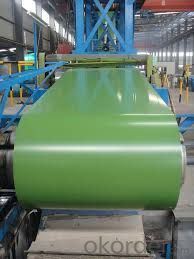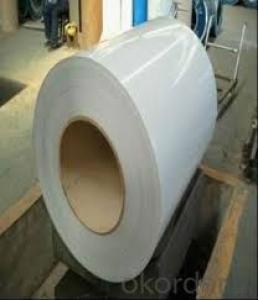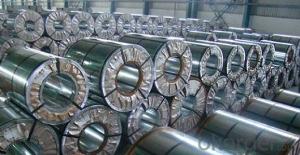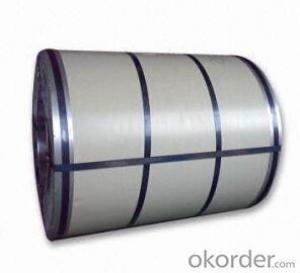Manufacturing Prepainted Galvanized Steel with Zinc Coated
- Loading Port:
- Shanghai
- Payment Terms:
- TT OR LC
- Min Order Qty:
- 25 m.t.
- Supply Capability:
- 10000 m.t./month
OKorder Service Pledge
OKorder Financial Service
You Might Also Like
Product Description
Color Coated Galvanzied Steel
1, Grade: SGCC, PPGI CGCC, SGLCC
2, Width: 800-1250mm
3, Thickness: 0.3-1.0mm
4, Color: ALL RAL
* Base Material: Al-Zn Galvanized Steel Coil. SGLCC
* Top side: 15-25 microns primer microns polyester.
* Back side: 5-8 microns primer epoxy.
* Width: 800-1, 250mm
* Thickness: 0.3 -1.0mm Thickness tolerance: +/- 0.02mm
* Al-Zn coating: 30-150g /sq. M. Or can be provided as clients' requirements
* Color: All RAL colour is available or customer supplying the sample
* Inner diameter of coil: 508mm&610mm.
* Packing: Standard seaworthy packing or according to user's need.
* Weight of each coil: 9 tons max
* Guarantee/ warranty
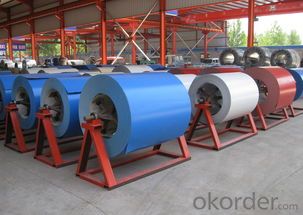
Usage
1. Used as roof panel, wall panel in steel structure in warehouse, factories, exibition hall container houses, cold storage,
2. It is also mainly used in light industry, automobile, construction, animal husbandry, fishery and commerce, etc.
Packing
1. Metal band strapping
2. Outside diameter ring
3. Label
4. Protective steel sheet
5. Water and rustproof paper
6. Steel sheet
Q&A Do you accept OA payment terms?
ANSWER: Yes, sure, but it normally depending on the order value
- Q: What are the different methods of cutting steel coils?
- There are several methods of cutting steel coils, including shearing, slitting, laser cutting, and plasma cutting. Shearing involves using a straight blade to cut through the coil, while slitting involves multiple circular blades that create narrower strips. Laser cutting uses a high-powered laser beam to melt and vaporize the steel, resulting in precise cuts. Plasma cutting uses a high-velocity jet of ionized gas to melt and blow away the steel, allowing for fast and accurate cuts.
- Q: 3 bedroom rambler with attached garage. A bad hail storm in May damaged my white siding and roof. I am concerned insurance adjustThanks much.er will not give me replacement value for steel siding. Any one know the cost and where to buy in Minnesota.
- they both cost around the same
- Q: How are steel coils used in the manufacturing of metal containers?
- Steel coils are used in the manufacturing of metal containers as they are processed into flat sheets or strips, which are then cut, formed, and welded to create the desired shape and size of the container. The coils provide a strong and durable material that can withstand the pressure and weight of the contents inside the container, ensuring its structural integrity and longevity.
- Q: If needed for Defence could a stainless steel sword kill someone my buddy wanted this sword for Defece after it is sharpend here is a picture
- Ya it could kill someone if it was sharpened enough but from experience stainless steel swords don't get as sharp as Carbon or higher grade steel. Not to mention it would probably bend if you hit someone with it all the way. Hell the one I let some people who were chopping a bush ( just a normal bush ) they were playing around and it got bent. I'm going to say I can't suggest a stainless steel sword for anything other then handing on your wall. Not even going into the whole If you use a sword for self defense is it considered self defense? debate. It's a sketchy situation not to mention you would need training with a sword to actually use it without it just getting brushed off.
- Q: What are the different methods of coil recoiling for steel coils?
- There are several different methods of coil recoiling for steel coils, each with its own advantages and applications. Some of the common methods include: 1. Slitting and rewinding: This method involves cutting the wide steel coil into narrower strips, which are then rewound into smaller coils. Slitting machines with circular blades are typically used to cut the steel, and the rewinding process ensures tight and uniform winding of the narrower strips. This method is widely used in industries such as automotive, construction, and packaging. 2. Rewinding with tension control: In this method, the steel coil is unwound and rewound with the help of tension control systems. These systems maintain even tension throughout the recoiling process, ensuring consistent winding quality. This method is particularly useful when dealing with delicate or sensitive materials that require gentle handling. 3. Recoiling with edge trimming: Sometimes, the edges of steel coils may be damaged, uneven, or contain defects. In such cases, edge trimming can be employed along with the recoiling process. Edge trimming machines remove the defective sections, resulting in coils with smooth and consistent edges. 4. Recoiling with surface treatment: Surface treatment methods like oiling, coating, or galvanizing are often applied to steel coils to enhance their corrosion resistance or improve their surface properties. Recoiling can be done in conjunction with these treatments, ensuring proper application and uniform coverage on the entire coil surface. 5. Recoiling with tension leveling: Tension leveling is a process that helps eliminate coil shape defects, such as coil set or crossbow, by applying tension during recoiling. This method ensures that the final coil has a flat and even shape, which is beneficial for subsequent processing and manufacturing operations. 6. Recoiling with precision slitting: Precision slitting is a specialized method used to achieve extremely narrow strip widths or tight tolerances in the steel coil. It involves precise control of the slitting knives and the winding tension to ensure accurate and consistent strip dimensions. This method is commonly used in industries that require high precision, such as electronics or precision engineering. Overall, the choice of coil recoiling method depends on various factors including the desired coil dimensions, material characteristics, surface requirements, and the specific application or industry involved. Manufacturers often utilize a combination of these methods to meet the diverse needs of their customers.
- Q: What are the different methods of storing steel coils?
- There are various ways to store steel coils depending on the specific requirements and limitations of the storage facility. Some commonly used methods include: 1. Stacking: Steel coils are stacked on top of one another in a stable manner, maximizing vertical space. However, careful stacking is necessary to maintain stability and prevent damage. 2. Block stacking: Steel coils are arranged in blocks, with each coil placed directly on top of another. The blocks are then stacked to optimize space. This method provides stability and easy access to individual coils, but additional equipment may be needed to prevent damage. 3. Coil cradles: These are specialized racks or frames designed to hold steel coils horizontally. They offer support and prevent rolling or shifting, making them suitable for smaller coils or when quick access is required. 4. Coil saddles: U-shaped frames specifically designed to hold and support steel coils vertically. They are often used in conjunction with block stacking or stack storage methods, providing stability and preventing rolling or collapsing. 5. Coil racks: Steel structures designed to hold multiple coils in an organized manner. They can have multiple levels or tiers, maximizing space efficiency. Coil racks are typically used for larger coils and can be customized for specific dimensions. 6. Automated storage systems: In large-scale facilities, mechanical systems such as coil cranes or coil carousels are used to transport and store steel coils. These systems ensure efficient and fast retrieval in high-volume operations where frequent coil handling is necessary. When determining the most suitable storage method for steel coils, factors such as size, weight, accessibility, and environmental conditions should be considered. Proper handling, labeling, and regular inspections are also crucial for maintaining the integrity and longevity of the stored coils.
- Q: Is there any other way of testing whether or not you have a 1944 Steel penny that won't damage the penny. The magnet test doesn't seem to work cause even when I try to get a 2007 penny to stick to the magnet...it won't. So is there some kind of magnet needed? Like power wise or anything like that, if not then I need to know what are other ways of testing the 1944 penny.
- Weigh it. I'm not an expert on coins, but if the 1944 was 100% steel, I would expect it to weigh something different then modern pennies. Another test would be to measure the resistance with a micro-ohm meter. This is a specialized device that can measure resistance to a millionth of an ohm. Steel should have a different resistance than the metals used on other pennies. Here are some comments from wikipedia: In 1943, at the peak of World War II, cents of zinc-coated steel were made for a short time due to war demands for copper. A few (the U.S. Mint reports forty) copper cents from 1943 were produced from the 1942 planchets remaining in the bins. Similarly, some 1944 steel cents have been reported. Following 1943, salvaged ammunition shells made their way into the minting process, and it was not uncommon to see coins featuring streaks of brass or having a considerably darker finish than other issues.
- Q: I need to construct a table with three columns, which states the name of the steel, its compositions (e.g. Fe and C), and its special properties for a variety of different steel products.Help me please, a site with info would be great, explanations would be even better.
- Steel is an alloy consisting mostly of iron, with a carbon content between 0.2% and 2.1% by weight, depending on the grade. Carbon is the most common alloying material for iron, but various other alloying elements are used, such as manganese, chromium, vanadium, and tungsten.[1] Carbon and other elements act as a hardening agent, preventing dislocations in the iron atom crystal lattice from sliding past one another. Varying the amount of alloying elements and form of their presence in the steel (solute elements, precipitated phase) controls qualities such as the hardness, ductility, and tensile strength of the resulting steel. Steel with increased carbon content can be made harder and stronger than iron, but is also less ductile. H.
- Q: What are the different methods of coil edge trimming?
- There are several methods of coil edge trimming, including shearing, slitting, and laser cutting. Shearing involves cutting the edges of the coil using a large blade or shear. Slitting involves making multiple cuts along the coil's edges using a slitting machine equipped with circular blades. Laser cutting uses a high-powered laser beam to precisely cut the coil's edges. Each method has its own advantages and is chosen based on factors such as the material being trimmed and the desired precision of the cut.
- Q: How are steel coils inspected for yield strength?
- Steel coils are inspected for yield strength through a series of testing methods. The most common and widely used method is the tensile test. In this test, a small sample is taken from the steel coil and subjected to a controlled load until it reaches its yield point. During the tensile test, the sample is gradually stretched until it deforms and ultimately breaks. The load and elongation data are continuously recorded during this process. The yield strength is then determined by identifying the point on the stress-strain curve where the material begins to exhibit plastic deformation or permanent elongation. Another method used to inspect steel coils for yield strength is the hardness test. Hardness is often correlated with yield strength, and therefore, a hardness test can provide an estimation of the material's yield strength. This test involves measuring the resistance of the steel coil's surface to indentation or penetration using instruments like a Rockwell or Brinell hardness tester. Additionally, non-destructive testing methods such as ultrasonic testing and magnetic particle inspection can also be employed to evaluate yield strength. Ultrasonic testing involves the use of high-frequency sound waves to detect any internal defects or inconsistencies in the material's structure. Magnetic particle inspection, on the other hand, relies on the application of magnetic fields and the use of magnetic particles to identify surface cracks or defects. Overall, various testing methods are available to inspect steel coils for yield strength. These methods provide manufacturers and inspectors with valuable information about the quality and performance capabilities of the steel, ensuring that it meets the required standards and specifications.
Send your message to us
Manufacturing Prepainted Galvanized Steel with Zinc Coated
- Loading Port:
- Shanghai
- Payment Terms:
- TT OR LC
- Min Order Qty:
- 25 m.t.
- Supply Capability:
- 10000 m.t./month
OKorder Service Pledge
OKorder Financial Service
Similar products
Hot products
Hot Searches
Related keywords




